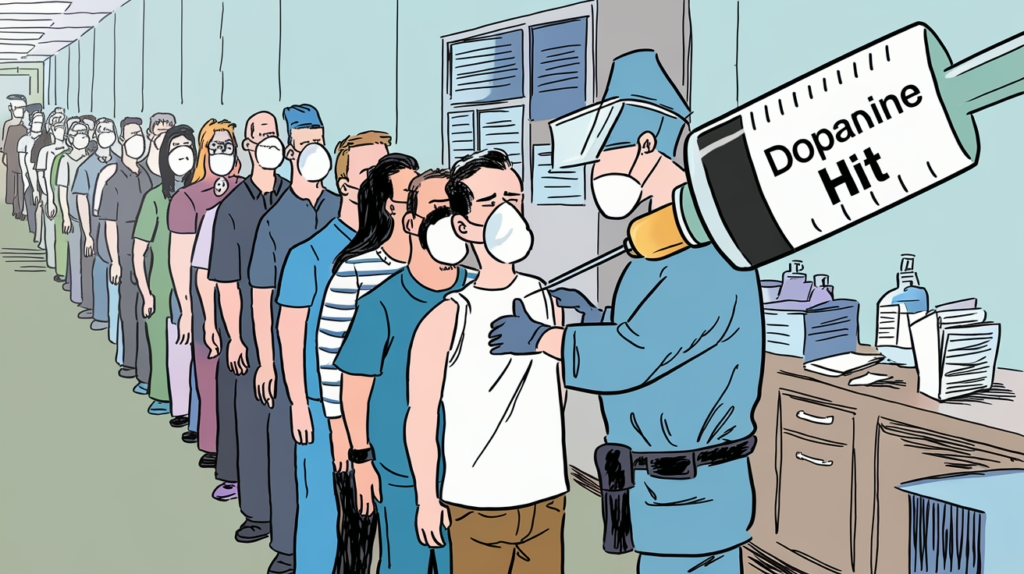First Let’s cover the science part :
Dopamine, often referred to as the “feel-good” neurotransmitter, is believed to be released in the brain as a reward for pleasurable or satisfying activities.
In popular culture and media, dopamine is often portrayed as the main chemical of pleasure, but the current opinion in pharmacology is that dopamine instead confers motivational salience; in other words, dopamine signals the perceived motivational prominence (i.e., the desirability or aversiveness) of an outcome, which in turn propels the organism’s behavior toward or away from achieving that outcome.
Now let’s jump into the statement i made:
How We Get Our Dopamine Hits, Separates Those Who Will Succeed From The Rest. – Abdallah Alaili
No, i am not a fortune teller, i can not predict the future, and the statement i made is not based on some complicated psychological insight into the human nature. However, the state of the digital addiction have become so dire that it’s visible how people are wasting their lives away.
At the heart of this pandemic is obviously social media in all it’s platforms, and the way they create an echo box to keep you hooked, trying to get your next dopamine hit. Spending hours scrolling facebook, instagram, tiktok, twitter or even youtube, is a certain way to waste time and gain in more cases nothing but a cheap dopamine hit, that further anchors your addiction.
Of course there are numerous other ways to get the dopamine hit. Here are various ways people get their dopamine hits:
1. Entertainment and Media
- Watching movies, series or even binge-watching TV shows.
- Playing video games, especially those with achievements or rewards.
- Scrolling through social media platforms and getting likes or comments.
- Listening to music or podcasts that match their mood.
2. Physical Activities
- Exercising, running, or engaging in sports (the “runner’s high”).
- Dancing or practicing yoga.
- Engaging in outdoor activities like hiking or cycling.
- Physical intimacy or sexual activity.
3. Achievements and Goals
- Completing a task or crossing items off a to-do list.
- Learning a new skill or mastering a hobby.
- Achieving personal or professional milestones.
- Solving a challenging problem or puzzle.
4. Food and Drink
- Eating favorite or “comfort” foods, especially those rich in sugar or fat.
- Drinking caffeine (coffee, tea, energy drinks).
- Trying new cuisines or dining out at favorite restaurants.
- Snacking mindlessly, often as a quick dopamine hit.
5. Social Interactions
- Spending quality time with friends and family.
- Engaging in deep conversations or meaningful connections.
- Receiving compliments or recognition.
- Participating in group activities or events.
6. Shopping and Materialism
- Buying something new, whether necessary or impulsive (retail therapy).
- Receiving packages or online shopping deliveries.
- Window shopping or browsing online stores.
7. Mental Stimulation
- Solving puzzles or playing brain games.
- Reading books or consuming educational content.
- Daydreaming or engaging in creative activities like painting or writing.
- Watching motivational or inspiring content.
8. Risk and Excitement
- Gambling or betting.
- Engaging in extreme sports or risky activities.
- Trying something adventurous or stepping out of their comfort zone.
9. Substances
- Drinking alcohol or smoking.
- Using recreational drugs.
- Consuming stimulants like nicotine or caffeine.
10. Mindfulness and Relaxation
- Meditating or practicing mindfulness.
- Taking a relaxing bath or spa day.
- Enjoying the sunset, nature, or quiet moments.
11. Acts of Kindness
- Helping others or volunteering.
- Donating to charity or contributing to a cause.
- Giving compliments or small gifts.
12. Personal Habits and Rituals
- Engaging in hobbies or passions like reading, gardening, cooking, or crafting.
- Following routines that provide a sense of accomplishment.
- Journaling or reflecting on positive experiences.
The ways people get their dopamine hit often reflect their personality, habits, and environment. However, balance is crucial, as some sources (like addictive behaviors or excessive indulgence) can lead to unhealthy patterns over time.
Not all dopamine hits are equal!
1- Creators VS. Consumers:
There is a huge difference between creators and consumers. People creating content are getting the dopamine hit when they see validation of their content. This is positive when the content is created from a business perspective rather than a personal perspective. Consumers of content, for entertainment purposes, are just getting the dopamine hit associated with entertainment.
2- Hobby VS. Addiction:
When i was a kid, i loved reading, i used to read for hours non stop. I know there are a lot of people that love reading. Reading is a nice hobby, but it can easily become an addiction. Just like watching a youtube video to get some information about a subject, reading can also become a nonending quest to read for the sake of reading and amassing absolutely useless information. We live in the era of information overload, it does not matter the source, whether it is books, podcasts, documentaries, youtube, or any other source, we need to know how to manage our information intake, or become slaves to this process of information intake.
3- Constructive VS. Time Wasting:
At the end of the day, what matters most is whether your dopamine hit can be considered constructive or just a waste of time. Watching or reading about self improvement and then applying these tips, is constructive, but watching and reading about self improvement and not doing it is an absolute waste of time.
To succeed in life, you will need to work on yourself and be productive, and there’s no easier way to achieve that, than tuning your dopamine intake to coincide with what is needed for your growth and success.
